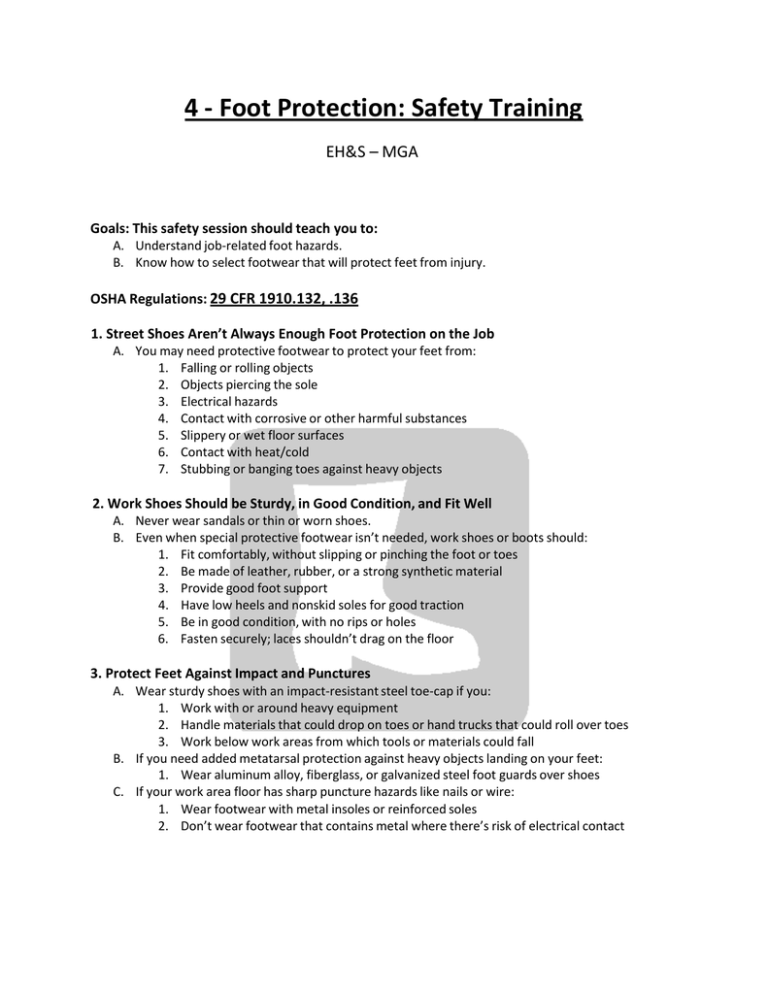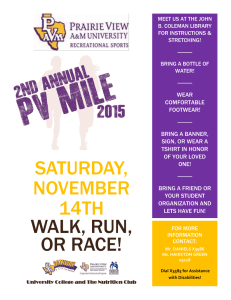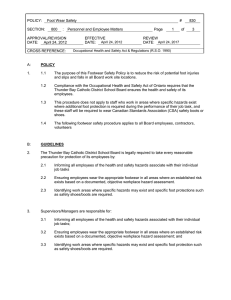4 - Foot Protection: Safety Training
advertisement

4 - Foot Protection: Safety Training EH&S – MGA Goals: This safety session should teach you to: A. Understand job-related foot hazards. B. Know how to select footwear that will protect feet from injury. OSHA Regulations: 29 CFR 1910.132, .136 1. Street Shoes Aren’t Always Enough Foot Protection on the Job A. You may need protective footwear to protect your feet from: 1. Falling or rolling objects 2. Objects piercing the sole 3. Electrical hazards 4. Contact with corrosive or other harmful substances 5. Slippery or wet floor surfaces 6. Contact with heat/cold 7. Stubbing or banging toes against heavy objects 2. Work Shoes Should be Sturdy, in Good Condition, and Fit Well A. Never wear sandals or thin or worn shoes. B. Even when special protective footwear isn’t needed, work shoes or boots should: 1. Fit comfortably, without slipping or pinching the foot or toes 2. Be made of leather, rubber, or a strong synthetic material 3. Provide good foot support 4. Have low heels and nonskid soles for good traction 5. Be in good condition, with no rips or holes 6. Fasten securely; laces shouldn’t drag on the floor 3. Protect Feet Against Impact and Punctures A. Wear sturdy shoes with an impact-resistant steel toe-cap if you: 1. Work with or around heavy equipment 2. Handle materials that could drop on toes or hand trucks that could roll over toes 3. Work below work areas from which tools or materials could fall B. If you need added metatarsal protection against heavy objects landing on your feet: 1. Wear aluminum alloy, fiberglass, or galvanized steel foot guards over shoes C. If your work area floor has sharp puncture hazards like nails or wire: 1. Wear footwear with metal insoles or reinforced soles 2. Don’t wear footwear that contains metal where there’s risk of electrical contact 4. Select Footwear Materials That Protect Against Other Job Hazards A. Wear impermeable rubber or neoprene boots if you work with corrosives or hazardous chemicals. B. Check safety data sheets for specific recommendations. C. Wear impermeable footwear either alone or over other work shoes. D. Wear shoes with nonconductive soles and no nails or other metal if you work with live electric power. E. Wear rubber boots or shoes or leather shoes with special soles that provide traction if you work on wet floors. F. Wear footwear with heat-resistant soles if you work on hot floors. G. Wear insulated footwear if you work in cold or wet areas. H. Wear removable over-the-ankle spats if you could get splashed by hot metal or welding sparks that might land in your shoes or boots. I. Don’t tuck pants in or wear shoes with tongues around hot sparks. 5. Inspect and Maintain Work Shoes A. B. C. D. Check footwear before use to be sure there are no rips or holes. Repair or replace footwear that can’t give you good protection. Decontaminate boots or boot covers that contact hazardous substances. Keep all components of footwear, particularly treads on the soles, clean. 6. Prevent Foot Injuries A. B. C. D. Identify foot hazards and select proper protection before starting any job. Take care not to drop tools, materials, and heavy objects. Keep aisles clear of spills and tripping hazards. Walk, don’t run. Summation: Prevent Broken Bones, Burns, and Other Foot Injuries Wear sturdy shoes or boots that are designed to protect your feet from injury and to give you good footing in all work conditions.


